
Driver: Parallel Lines
Written by: Rik
Date posted: March 17, 2014
- Genre: Racing
- Developed by: Reflections
- Published by: Ubisoft
- Year released: 2007
- Our score: 6
The original Driver was heralded as a classic on the PSX, although it was received with slightly more sober praise on PC. Personally, I always felt it was a little overrated, preferring the superior, if slightly nerdier, charms of PC-only title Midtown Madness. Console snobbery aside, the latter was released first and had better graphics and more features, and – most importantly – provided a more rounded racing experience.
Although Driver didn’t necessarily occupy exactly the same ground as Midtown, it was still mainly about driving around in a city as fast as possible, regardless of whatever ham-fisted plot was attached to it. Over the years, though, the Driver series seemed keener on trying to occupy the same territory as Grand Theft Auto: the second game (never released on PC) gave your character freedom to leave his vehicle, while the third saw money pumped into glossy graphics, celebrity voiceovers and advertising campaigns. Neither was a critical success, and the stock of the series famously plummeted after the ridiculously-named Driv3r was rush-released and panned by reviewers for being badly designed and riddled with bugs, with the on-foot sections being an area of particular concern.
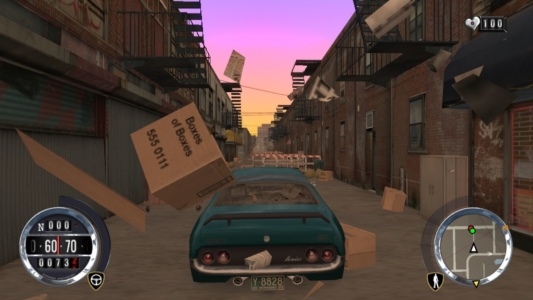
It just wouldn’t be a Driver game without the opportunity to drive through some discarded cardboard boxes in an alleyway.
We did consider covering that one by the way, but eventually decided against it – while there was certainly some potential for a few cheap ho-ho, hee-hee type laughs, it would still involve spending time playing what is generally considered to be a pretty bad game, and so on this occasion we decided to just skip ahead to the one that the developers actually had time to fashion into a playable product. (None of which precludes us from revisiting it at some point in the future, although in the meantime I’m sure there are plenty of enterprising souls highlighting its shortcomings on YouTube). Such a throwaway comment owes nothing to research, of course, but rightly or wrongly, initial impressions of Parallel Lines are of a rather low-key attempt to somehow piece together something decent from the debris of the previous high-profile disaster and that sights were lowered from aiming to be the genre leader to something altogether more conservative: a solid, playable game that actually works.
Parallel Lines ditches the series’ previous protagonist, undercover cop Tanner, replacing him with a cocky young getaway driver known as ‘The Kid’ (or ‘TK’ for short). In an opening boob-laden cinematic, TK introduces us to his world: New York, 1978, ‘the place to be’ for a young guy from the country looking to have a good time. A life of looking at girls in bikinis and committing petty crime while living above a garage is good enough for TK, until his mechanic friend Ray suggests he move up to the big leagues. For the first half of the game, this all seems to be going well enough until, with crime being what it is, TK ends up getting arrested and sentenced to 28 years in prison, at which point Parallel Lines skips ahead to 2006 and TK’s release. With his skills and motivation remarkably unaffected by a lengthy spell inside, TK immediately embarks upon a new series of driving-based missions in order to right the wrongs of the circumstances that led to his incarceration.
As with the original Driver, the story isn’t the best, in this case being relayed via blurry footage of dead-eyed mannequins acting out a teenage boy’s version of an adult crime thriller that earns an 18 certificate only by virtue of some unnecessarily sweary dialogue and rather gratuitous shots of semi-nude CGI ladies. On top of that, TK himself is a bit of a smarmy know-it-all tosser, which makes it hard to really care too much about what happens to him.
Getting into the game itself, early missions serve to highlight the direction the series has taken. As is the tradition with more modern titles, the opening levels introduce you, in a fairly obvious manner, to the core skills required to play. Aside from the obvious getaway from the cops (you’re dumped straight into the action, mid-chase), you’re also given an opportunity to experience the on-foot action via a shooting gallery tutorial, while the concept of taking side jobs for cash is revealed under the auspices of helping your buddy Ray out of a financial jam. After being required to steal a car during another early mission, you’re also taken through (at a rather laboured pace that suggests it might be important) the various options for storing, maintaining, and upgrading them at any one of the three garages dotted around the city.
The overwhelming and unavoidable impression is that the whole thing looks and feels a lot like second-generation Grand Theft Auto. What’s strange though is that you’re left feeling that it didn’t need to be this way. The third person combat with auto aiming, my least favourite part of the GTA games, feels like an unnecessary addition, almost as if the developers just wanted to show that they could make these sections work. Work they certainly do, but they add very little to the game – something to be endured rather than enjoyed. Equally, there seems little point in doing extra jobs to earn money, or storing or upgrading cars, seeing as you can steal or jack any vehicle at any time. When having an extra fast car becomes more important, the game handily fills the streets with them. (Also, why don’t you get any money for doing any of the career missions?) Even guns and ammo appear miraculously at your house without you even asking. And finally, even though New York is recreated in some detail and with considerable affection, there’s very little to do that makes any exploration outside the missions a worthwhile endeavour.
Elsewhere, the feeling persists that some of the original’s distinctive qualities have been lost, from the stylised, washed out graphical style, to the exaggerated tail-heavy handling model, and the replay/film director mode. Even the signature 70s setting is abandoned midway through and muscle cars are replaced with dull saloons, while the licensed soundtrack switches from Bowie and Blondie (Parallel Lines! Of course!) to dreary modern pap.
Still, once you realise that many of the sundry features can be ignored and simply treat Parallel Lines as a series of linear missions (which it is: although you do have some choice about which order you do some of them in, this doesn’t make any difference to the outcome), skipping straight from one to the other using the map rather than moving through town in-game and attracting police attention through accidental crap driving, there’s some fun to be had. Thrilling movie-style city-centre car chases are the order of the day, and Parallel Lines has enough expertise behind it in this regard to deliver the core action effectively. Even the ‘shooting while driving’ mechanic works pretty well, although if you’re anything like me, you’ll also have to abandon your controller unless you can actually cope with [expletive deleted] dual analogue stick controls – mouse and keyboard work fine, though.
The difficulty level has been toned down a little, too, which will come as a relief to anyone who found the relentless tenacity of the cops in the original game a little wearing. Instead of having chases that last for days, you can now lose the fuzz through a nifty bit of weaving through traffic (you can even turn your gun on them, too, although inevitably this just raises your wanted meter and sends more cars a-coming). If anything, the missions are a little on the easy side this time around, with some being undermined by fairly moronic AI (on one occasion when required to deliberately provoke and prolong a chase, they were distracted at a crucial moment by a ramp leading to the roof of a building, and multiple cruisers congregated at the bottom while drug dealing gangsters shot my car to pieces). Still, the action zips along nicely, aided by generous checkpoint placement, without having too many frustrating multiple-repeat missions to sap your enthusiasm.
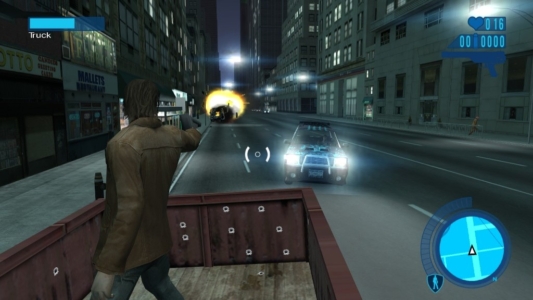
This screen makes this bit look a lot better than it is. I think I’ve just blown up a parked car, while any damage this chap has sustained is likely to be from driving aimlessly into lampposts at every opportunity.
On the negative side, the pure shooting sections are, as we mentioned, a little basic and tedious, while other minor quibbles include a chase camera that’s a little too close for my tastes (it feels too hard to judge the width of your vehicle, a bit like in real life when passing parked cars on a narrow road while flinching and holding your breath, fully expecting a clipped wing mirror but ultimately getting away with it) and some ramp jumping motorcycle bits that too readily recall Knight Rider: The Game (as well as 1980s kids TV show Kick Start). We’ve already mentioned the crap story, but it’s worth pointing out that TK is the sort of guy who is shocked by a single murder during a cut scene despite the fact he’s run over, collided with, or shot hundreds of others himself. Plus it sort of worries me that the only trouble he seems to have reintegrating into modern life involves working out the difference between the TV and DVD remotes.
Despite such niggles, overall there’s a fun few hours to be had here, and if the aim was indeed to produce a playable game that actually works, then Parallel Lines can largely be judged a success. Crucially, the actual driving bits are solid and well-balanced, and for me it was more enjoyable than the original Driver – although this is a significantly newer game, so there’s an argument that says, well, so it bloody should be. And while some of the time between the two games has been spent fixing up bits that arguably should never have been introduced to the series in the first place, the fact that it all hangs together shouldn’t detract from the simple truth that other games had this kind of thing nailed down years ago: as a result, the end product seems a little dated and derivative. Still, if you accept that there’s room in the market for a game that focuses more on the driving and less on the crime-ing, as I do, then the main question to ask is whether playing Parallel Lines is successful in making you feel like you’re in a tightly-choreographed car chase like in the films on the telly. And the answer to that question is yes.

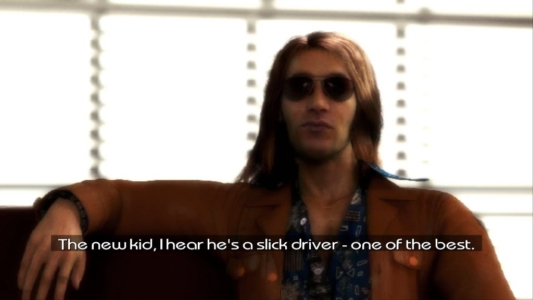
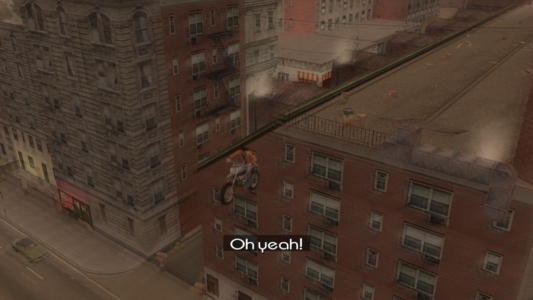
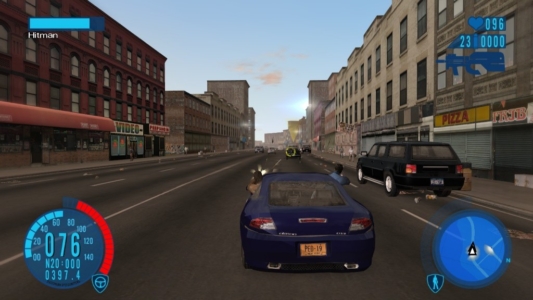

 Posts
Posts
Oh, God, that mission with the ramps you have to lead the cops up is heinous. It took me at least seven attempts that were aborted due to either a: losing the cops on accident, b: they got out of the car (and never get back in), or in one glorious case, I saved the boat for last and was about to make it with seconds to spare only to find out the path I took was blocked off.
April 21, 2014 @ 7:18 am
It was annoying but I think I got lucky with a successful attempt before I really started to lose my temper. The bike-ramp-jumping mission where you follow the helicopter was the most annoying one for me.
April 22, 2014 @ 11:11 am